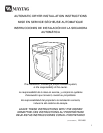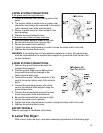
9
INSTALLATION
Parts and literature are packaged inside of dryer drum.
To Install…
1. Move dryer to an appropriate location for installation. Consider installing the dryer before the
washer in side-by-side installations, to allow access to gas, electrical and exhaust connections.
Lay two of the carton corner posts on the floor. Tip the dryer forward on its front so it will lay
across both corner posts.
2. Set the dryer back in an upright position.
3. Review the Exhausting Section before installing the exhaust system. Install the ductwork from the
dryer to the exhaust hood. The crimped end of the duct sections must point away from the dryer.
DO NOT use sheet metal screws when assembling ducting. These joints should be taped. Never
use plastic flexible exhaust material.
Tip for tight installations: install a section of exhaust system to the dryer before moving the dryer
in place. Use duct tape to secure this section to the dryer but do not cover louvers in dryer
cabinet.
4. Review Electrical Requirements Section.
BEFORE OPERATING OR TESTING, follow the grounding instructions in the Grounding Section.
U.S. MODELS:
IMPORTANT – All U.S. models are produced for a 3-WIRE SYSTEM CONNECTION. The dryer
frame is grounded to the neutral conductor at the terminal block.
A 4-WIRE SYSTEM CONNECTION is required for new or remodeled construction, mobile homes,
or if local codes do not permit grounding through neutral. If the 4-wire system is used, the dryer
frame cannot be grounded to the neutral conductor at the terminal block. Refer to the following
instructions for 3- and 4-WIRE SYSTEM CONNECTIONS.
Remove the terminal block cover plate.
Insert the power cord with a U.L. listed strain relief
through the hole provided in the cabinet near the terminal
block. NOTE: a strain relief must be used.
Do not loosen the nuts already installed on the terminal
block. Be sure they are tight. Use a 3/8” (1 cm) deep well socket.














